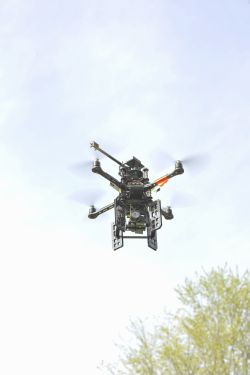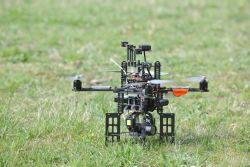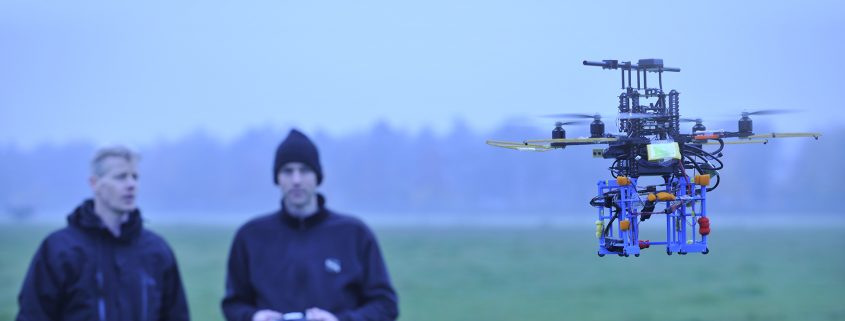
NLR’s quadrocopter, a helicopter with four rotors
NLR’s developments and applications for quadrocopters proceeding rapidly
The National Aerospace Laboratory recently had a quadrocopter research platform, named the ‘Pelican’, placed at its disposal. This platform, from supplier Ascending Technologies, is vital, since activities involving quadrocopters have increased enormously in recent years. The platform is designed specifically for the research objectives of universities and other research institutes.
NLR’s quadrocopters (helicopters with four rotors) have for years been sources of wonder and admiration. NLR activities with quadrocopters started a few years ago as an interim project. Nowadays, in addition to interim activities, an increasing number of quadrocopter activities occur within full projects. And thus it was last week that the Pelican was used to provide support for the Shared Airborne Video Experiment (SHAVE), a Netherlands Ministry of Defence project for which NLR is prime contractor. The aim of the SHAVE project is to create an inventory detailing the processes and technical infrastructures needed for disseminating live video material within networks to users that have varying bandwidth capacities.
There is also a need to include the requirements when using future High Definition (HD) video materials. To help facilitate this, the Pelican was equipped with an HD camera.
For the purpose of creating video material, recordings were made on Tuesday, 29 March 2011, at the Camp ‘de Kiek’ in Riel (NL). Various scenarios were enacted, of which recordings were made by NLR’s Pelican. These recordings will be used as test material in user experiments within SHAVE.
The NLR Pelican also serves a fundamental role within the Firefly project. This project aims to create an Unmanned Aircraft System (UAS) prototype that is easy to deploy and operate during police and fire-fighting emergencies. For the KLPD, of primary importance is that a UAS system be easy to operate while maintaining the focus on the primary task at hand – the reception of visual information. Further, the KLPD wants to limit the need for training. To this end, a tablet computer is used as ground control station for the Pelican. To this end NLR’s ‘MUST’ ground station is serving as frame of reference. Images are derived from a special Megapixel IP camera onboard the Pelican and made available within the Crisis Management System via the tablet computer in real time.
TU Delft interns and graduates are also working on the quadrocopter activities. Moreover, the Pelican helps to establish closer collaborative efforts between NLR and polytechnic universities.

NLR’s developments and applications for quadrocopters proceed rapidly
Development and application for quadrocopters are proceeding rapidly, whereby quadrocopters are becoming increasingly proficient at operating autonomously both indoors and outdoors. In addition to projects for governmental organisations (The Netherlands Ministry of Defence, KLPD and Fire Services), other sectors, including agricultural and maritime engineering, are increasing interested.
These quadrocopters activities not only prove that ‘size doesn’t matter’ but also that small facilities can lead to big business.



